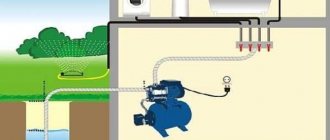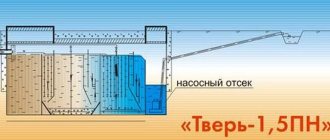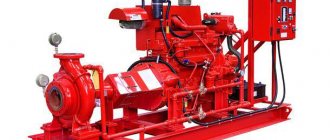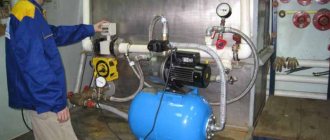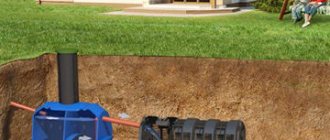Ejector - what is it? This question often arises among owners of country houses and dachas in the process of arranging an autonomous water supply system. The source of water entering such a system, as a rule, is a pre-drilled well or well, the liquid from which must not only be raised to the surface, but also transported through a pipeline. To solve such problems, a whole technical complex is used, consisting of a pump, a set of sensors, filters and a water ejector, installed if liquid from the source needs to be pumped out from a depth of more than ten meters.
Water jet ejector with flange connections
In what cases is an ejector needed?
Before dealing with the question of what an ejector is, you should find out why a pumping station equipped with it is needed. Essentially, an ejector (or ejector pump) is a device in which the energy of motion of one medium moving at high speed is transferred to another medium. Thus, the operating principle of an ejector pumping station is based on Bernoulli’s law: if a reduced pressure of one medium is created in a narrowing section of the pipeline, this will cause suction into the formed flow of another medium and its transfer from the suction point.
Everyone knows well: the greater the depth of the source, the harder it is to raise water from it to the surface. As a rule, if the depth of the source is more than seven meters, then a conventional surface pump has difficulty performing its functions. Of course, to solve this problem, you can use a more productive submersible pump, but it is better to go the other way and purchase an ejector for a surface-type pumping station, significantly improving the characteristics of the equipment used.
External ejector prepared for immersion into the well
By using a pumping station with an ejector, the liquid pressure in the main pipeline increases, while the energy of the fast flow of the liquid medium flowing through its separate branch is used. Ejectors, as a rule, work in conjunction with jet-type pumps - water-jet, liquid-mercury, steam-mercury and steam-oil.
An ejector for a pumping station is especially relevant if it is necessary to increase the power of an already installed or planned installation of a station with a surface pump. In such cases, the ejector installation allows you to increase the depth of water intake from the reservoir to 20–40 meters.
Overview and operation of a pumping station with an external ejector
Design features and principle of operation
The design elements of the remote ejector for the pump are:
- a chamber into which the pumped medium is sucked;
- mixing unit;
- diffuser;
- a nozzle whose cross-section tapers.
Remote ejector device
How does any ejector work? As mentioned above, such a device operates according to the Bernoulli principle: if the speed of the flow of a liquid or gaseous medium increases, then an area characterized by low pressure is formed around it, which contributes to the rarefaction effect.
If you choose the right pipe shape and flow rate, then air or liquid will be sucked into the outlet located in the narrowed part
So, the operating principle of a pumping station equipped with an ejector device is as follows:
- The liquid medium pumped by the ejector unit enters the latter through a nozzle, the cross-section of which is smaller than the diameter of the inlet line.
- Passing into the mixer chamber through a nozzle with a decreasing diameter, the flow of the liquid medium acquires a noticeable acceleration, which contributes to the formation of an area with reduced pressure in such a chamber.
- Due to the occurrence of a vacuum effect in the ejector mixer, a liquid medium under higher pressure is sucked into the chamber.
If you decide to equip a pumping station with a device such as an ejector, keep in mind that the pumped liquid medium does not enter it from a well or well, but from the pump. The ejector itself is positioned in such a way that part of the liquid that was pumped out of the well or well by means of a pump is returned to the mixer chamber through a tapering nozzle. The kinetic energy of the liquid flow entering the ejector mixer chamber through its nozzle is transferred to the mass of the liquid medium sucked by the pump from the well or well, thereby ensuring constant acceleration of its movement along the inlet line. Part of the liquid flow, which is pumped out by a pumping station with an ejector, enters the recirculation pipe, and the rest goes into the water supply system served by such a station.
Connecting a pump with an external ejector
Once you understand how a pumping station equipped with an ejector works, you will understand that it requires less energy to raise water to the surface and transport it through a pipeline. Thus, not only does the efficiency of using pumping equipment increase, but also the depth from which the liquid medium can be pumped out increases. In addition, when using an ejector that sucks up liquid on its own, the pump is protected from running dry.
The design of a pumping station with an ejector includes a tap installed on the recirculation pipe. Using such a valve, which regulates the flow of liquid flowing to the ejector nozzle, you can control the operation of this device.
Operating principle of the ejector
The ejector design includes several elements - an ejecting water inlet pipe with a tapering nozzle and a main pipe with a side pipe for the ejected medium, a mixing chamber, a cylindrical neck, an expanding diffuser and an outlet pipe.
When ejecting water is supplied under pressure to the ejector, its speed in the nozzle increases sharply. In this case, a rarefaction zone is created in the mixing chamber and ejected water or gas begins to flow into it. Both media are mixed and, under pressure slightly less than the initial one at the entrance to the ejector, enter the output of the device.
Most submersible pumps purchased by private homeowners provide reliable operation at an aquifer depth of 7-10 m. Connection to an ejector circuit allows for reliable water supply from a depth of up to 20-40 m.
Using a homemade external option
The problem of the lack of an ejector can be solved by replacing the existing pump with another one with a built-in ejector, which will entail additional costs of money and time. A more economical option would be to make a simple external device with your own hands and install it in an existing water supply system.
Personal assembly of the ejector
To make a simple ejector device, you will need plumbing fittings that are always on hand or commercially available - a tee with internal threads, couplings and bends.
The main element is an unequal tee, into the lower part of which a fitting with an external thread is inserted. When installing the fitting, it is necessary to ensure that it does not reach the upper edge of the tee by 2-3 mm. To do this, if necessary, it is modified by filing or extending with a polyethylene tube. The fitting will play the role of a nozzle, so the vacuum in the tee body and the water pressure at the outlet depend on the accuracy of its installation.
A polyethylene pipe is connected to the top of the tee through an adapter to supply water to the system. On the thread of the lower part, in addition to the fitting, there is an outlet for supplying recirculated water from the pump. To draw water from a well or a well, a side pipe of a tee with a polyethylene tube connected through an outlet is used. Its diameter should be smaller than that of the main passage of the fitting.
As for the dimensions, for the manufacture of an ejector that provides water supply to a small house or cottage, it will be sufficient to use a ¾" tee with a ¾" side fitting and an internal fitting with a diameter of 12 mm.
Pipe connection procedure
To connect to adjacent elements of the system, you can use polyethylene or metal-plastic pipes. The pipe connected to the side pipe with the installed check valve and filter must be long enough to be immersed in the well; it is secured first.
A recirculation pipeline is connected to the lower end of the device with a narrowed fitting, connected to the water tank and necessary to create a return flow.
The upper part of the ejector is connected through a pipeline to the surface pump, and the assembly of the homemade ejector installation is completed.
https://www.youtube.com/watch?v=x4zICtMBRFY
Initial launch and further operation
For the initial start-up of a system with a mounted ejector, its elements, including all connected pipelines, must be vented and filled with water. The pump has a special fitting for filling it. The starting start of the pump is carried out with the valve closed at its pressure to de-air and completely fill the pipelines; the operating time should not exceed 10-20 seconds. By opening the tap, air is bled from the system; if necessary, several cycles of the operation are performed until the accumulator is filled and the pump automatically turns off.
Then the hydraulic accumulator is completely drained through the system's supply valves, and the pump, when the hydraulic reservoir is empty, must switch to automatic operation and turn on to fill it. If this does not happen, then errors were made when connecting the pipes or filling - a leak in the connection led to air leaks or the check valve at the water intake was clogged. In this case, you must repeat all of the above operations and restart the system.
Pros and cons of pumps with ejector
The ejector is economical and can work effectively with a relatively low-power engine. This is a mechanism that allows the transfer of kinetic energy from a fast medium to a slow one. In the most popular type of such pumps - with a remote ejector - part of the power is spent on water recirculation. At the outlet of the tap, the pressure is slightly less compared to what other types of pumps create.
Attention! A small amount of water is required to start the ejector. It forms a sufficient vacuum in the pipe and “leads” the main flow upward. The device should not run dry: this will lead to breakdown.
Disadvantages of the device:
- The width of the remote ejector is about 100 mm. It will not be possible to save on the diameter of the well.
- The performance of pumps with an ejector is lower than that of other self-priming hydraulic devices.
- The cost is higher than classic devices for lifting water from depth.
Advantages, principle of operation and installation details
A surface pump with an external ejector has the following advantages:
- work with great depths up to 50 meters;
- small dimensions and weight of the station;
- convenience of supplying water to the object;
- ability to work in extreme conditions – at temperatures from -20 to + 130 degrees.
Design and principle of operation of the internal ejector
Of course, not every steam ejector pump can boast all of the above advantages. So, some models can work in severe frost conditions, others cannot.
How does the device work?
The steam ejector pump has a fairly simple principle of operation - a small amount of water, which is located in a special tank of the device, is used to assist in drawing in liquid. The operating principle is simple but very effective.
Although, such a system does not have serious performance. But so far no one has invented a new pumping system that can draw liquid from greater depths. That's why a water ejector pump is so popular today.
The ejector for the pump is always lowered to the required depth for water intake, and the pumping system is mounted on the surface for ease of use and adjustment of the water intake system.
Types of ejector devices
According to their design and operating principle, ejector pumps can belong to one of the following categories.
Steam
With the help of such ejector devices, gaseous media are pumped out of confined spaces and a rarefied state of air is maintained. Devices operating on this principle have a wide range of applications.
Steam ejector for turbine with oil cooler
Steam jet
In such devices, the energy of a steam jet is used to suck gaseous or liquid media from a confined space. The operating principle of this type of ejector is that steam escaping from the nozzle of the installation at high speed carries with it the transported medium exiting through an annular channel located around the nozzle. Ejector pumping stations of this type are used primarily for rapid pumping of water from the premises of ships for various purposes.
Installation of water heating using a steam jet ejector
Gas
Stations with an ejector of this type, the operating principle of which is based on the fact that the compression of a gas medium, initially under low pressure, occurs due to high-pressure gases, are used in the gas industry. The described process takes place in the mixing chamber, from where the flow of the pumped medium is directed to the diffuser, where it is slowed down, and hence the pressure increases.
Air (gas) ejector for chemical, energy, gas and other industries
Choice: built-in or external?
Depending on the installation location, there are remote and built-in ejectors. There is no big difference in the design features of these devices, but the location of the ejector still affects in some way both the installation of the pumping station and its operation.
So, built-in ejectors are usually placed inside the pump housing or in close proximity to it. As a result, the ejector takes up minimal space and does not have to be installed separately; it is enough to carry out the usual installation of the pumping station or the pump itself.
In addition, the ejector located in the housing is reliably protected from contamination. Vacuum and reverse water intake are carried out directly in the pump housing. There is no need to install additional filters to protect the ejector from clogging with sludge particles or sand.
A remote ejector for a pumping station is more difficult to install than an internal model, but this option creates a much less noise effect
However, it should be remembered that this model demonstrates maximum efficiency at shallow depths, up to 10 meters. Pumps with a built-in ejector are designed for such relatively shallow sources; their advantage is that they provide excellent incoming water pressure.
As a result, these characteristics are sufficient to use water not only for domestic needs, but also for irrigation or other economic operations. Another problem is the increased noise level, since the vibration of the operating pump is added to the sound effect of water passing through the ejector.
If you decide to install a pump with a built-in ejector, you will have to take special care of sound insulation. It is recommended to install pumps or pumping stations with a built-in ejector outside the house, for example, in a separate building or in a well caisson.
The electric motor for a pump with an ejector must be more powerful than for a similar model without an ejector.
An external or external ejector is installed at a certain distance from the pump, and this distance can be quite significant: 20-40 meters, some experts even consider 50 meters acceptable. Thus, a remote ejector can be placed directly in a water source, for example, in a well.
The external ejector does not so much increase the pump’s performance as it is designed to increase the depth of water intake from the source, which can reach 20-45 m
Of course, the noise from the operation of an ejector installed deep underground will no longer disturb the residents of the house. However, this type of device must be connected to the system using a recirculation pipe through which the water will return to the ejector.
The greater the installation depth of the device, the longer the pipe will have to be lowered into the well or well.
It is better to provide for the presence of another pipe in the well at the design stage of the device. Connecting a remote ejector also involves installing a separate storage tank from which water will be drawn for recirculation.
Such a tank allows you to reduce the load on the surface pump, saving some energy. It is worth noting that the operating efficiency of the external ejector is somewhat lower than that of models built into the pump, however, the ability to significantly increase the intake depth makes one come to terms with this drawback.
When using an external ejector, there is no need to place the pumping station directly near the water source. It can be installed in the basement of a residential building. The distance to the source can vary within 20-40 meters; this will not affect the performance of the pumping equipment.
Types of ejectors
Ejector pumps can be steam, steam jet and gas. The general principle of their operation is identical. But the devices are activated in different ways. A pump with a steam-type ejector is used to pump out gaseous media from a closed volume. You can maintain the pressure at a negative level, making the environment rarefied. Scope of application: industry.
Steam jet design designed to work with gaseous media and liquids. The difference in the operation of an ejector device of this type is that the steam passing through the nozzle draws the pumped medium with it at high speed. Given their high performance, the scope of application of these devices is urgent pumping of water, for example, on a ship.
Gas type is a separate category of ejectors. The devices operate on compressed gas, which, mixed with the pumped medium, is directed into a diffuser to slow it down. After its passage, the mixture escapes through the nozzle hole. Such devices are intended mainly for the gas industry.
Built-in models
When understanding what an ejector is, it is necessary to consider the classification of these devices depending on the installation location. Built-in models are part of the structure, or rather, its component. The ejector can be attached to the pump itself or next to it on a single frame. Installation consists of attaching the block to the base and connecting the forces
The scheme works when water rises from a depth of 10 meters. The exact parameters are indicated in the technical documentation.
Installation is recommended to be done outside the home. This may be a well with a head installed, or a separate building. The reason for this is increased noise and vibration. If this is not possible, consider the following type of installation.
Remote models
In this case, the circuit must be supplemented with an additional tank for pumping liquid. The well must be wide enough to accommodate two hoses. Productivity in this case will decrease by a third due to a decrease in the diameter of the intake pipe. You will also need a separate pipeline for air supply.
But with this configuration, a vacuum area is created in the gas intake, which allows you to lift liquid from a height of more than 50 meters. In this case, the distance from the well to the consumer can be more than 40 meters. In this case, the pumping station can be installed indoors inside the house. This could be a basement, boiler room, storage room, etc.
Types of ejectors at installation site
When purchasing an ejector to equip a pumping station, keep in mind that such a device can be built-in or external. The design and principle of operation of these two types of ejectors are practically no different; the differences are only in the location of their installation. Built-in ejectors can be placed inside the pump housing or mounted in close proximity to it. The built-in ejection pump has a number of advantages, which include:
- minimum space required for installation;
- good protection of the ejector from contamination;
- there is no need to install additional filters that protect the ejector from insoluble inclusions contained in the pumped liquid.
Centrifugal pump with built-in ejector
Meanwhile, it should be borne in mind that built-in ejectors demonstrate high efficiency if they are used to pump water from sources of shallow depth - up to 10 meters. Another significant disadvantage of pumping stations with built-in ejectors is that they produce quite a lot of noise during their operation, so it is recommended to locate them in a separate room or in a caisson of a water-bearing well. It should also be borne in mind that the design of an ejector of this type involves the use of a more powerful electric motor, which drives the pumping unit itself.
A remote (or external) ejector, as its name suggests, is installed at a certain distance from the pump, and it can be quite large and reach up to fifty meters. Remote-type ejectors, as a rule, are placed directly in the well and connected to the system via a recirculation pipe. A pumping station with a remote ejector also requires the use of a separate storage tank. This tank is necessary to ensure that water is always available for recirculation. The presence of such a tank, in addition, makes it possible to reduce the load on the pump with a remote ejector and reduce the amount of energy required for its operation.
Pump with external ejector
The use of remote-type ejectors, the efficiency of which is slightly lower than that of built-in devices, makes it possible to pump out a liquid medium from wells of considerable depth. In addition, if you make a pumping station with an external ejector, then it can not be placed in the immediate vicinity of the well, but can be mounted at a distance from the water intake source, which can be from 20 to 40 meters. It is important that the location of pumping equipment at such a significant distance from the well will not affect the efficiency of its operation.
Making an ejector
Having understood what an ejector is and having studied the principle of its operation, you will understand that you can make this simple device with your own hands. Why make an ejector with your own hands if you can purchase one without any problems? It's all about saving. Finding drawings from which you can make such a device yourself does not present any particular problems, and to make it you do not need expensive consumables and complex equipment.
How to make an ejector and connect it to the pump? For this purpose you need to prepare the following components:
- female tee;
- union;
- couplings, elbows and other fitting elements.
Components for a homemade ejector
The ejector is manufactured according to the following algorithm.
- A fitting is screwed into the lower part of the tee, and this is done so that the narrow branch pipe of the latter is inside the tee, but does not protrude from its reverse side. The distance from the end of the narrow branch pipe of the fitting to the upper end of the tee should be about two to three millimeters. If the fitting is too long, then the end of its narrow pipe is ground off; if it is short, then it is extended using a polymer tube.
- An adapter with an external thread is screwed into the upper part of the tee, which will connect to the suction line of the pump.
- A bend in the form of an angle is screwed into the lower part of the tee with the fitting already installed, which will connect to the recirculation pipe of the ejector.
- A bend in the form of an angle is also screwed into the side branch pipe of the tee, to which a pipe supplying water from the well is connected using a collet clamp.
Homemade ejector assembly
All threaded connections made during the manufacture of a homemade ejector must be sealed, which is ensured by the use of FUM tape. On the pipe through which water will be drawn from the source, a check valve and a mesh filter should be placed, which will protect the ejector from clogging. For the pipes with which the ejector will be connected to the pump and storage tank, which ensures water recirculation in the system, you can choose products made from both metal-plastic and polyethylene. In the second option, installation does not require collet clamps, but special crimping elements.
After all the required connections are made, the homemade ejector is placed in the well, and the entire pipeline system is filled with water. Only after this can the first start-up of the pumping station be carried out.
Device installation features
As already mentioned, installing an ejector built into the pump does not cause any particular problems, since the device is already located in the device body. The surface pump is simply connected to the water supply hose on one side, and also to the water supply system on the other side.
If it is used as part of a pumping station, then the pump is connected to the hydraulic accumulator through a special fitting with five outputs. In addition, the pump will need to be connected to the contacts of the pressure switch to ensure that it turns on and off automatically.
This diagram clearly shows the procedure for connecting a remote ejector to a pumping station, indicating the installation locations of all necessary components.
Before turning on the surface pump, it must be filled with water through the filling hole provided for this purpose. You cannot turn on such equipment without water, it may burn. If the pump is installed correctly, the ejector will operate without interruption.
But the installation of a remote ejector is carried out according to a more complex scheme. First, you will need to install a pipe that will ensure the return flow of water from the storage tank to the ejector. A check valve is installed on the suction section of the ejector. A mesh filter should be placed behind it to protect the device from clogging.
An adjustment valve must be installed on top of the recirculation pipe to regulate the amount of water that is directed to the ejector. This unit is not mandatory, but can significantly improve the situation with water pressure in the house.
The less water is returned to the ejector, the more of it will be left for the home's plumbing system.
The ejector is assembled before operation according to the standard scheme. A mesh filter is connected to the ejector body from below, and a Venturi tube made in the form of a plastic socket is connected to the top through the nozzle (+)
This way you can influence the water pressure in the water supply. If it is insufficient, you should slightly tighten the adjusting valve on the return line.
If the pressure is too high and creates unnecessary stress on the plumbing system, it makes sense to direct more water to the ejector in order to increase the efficiency of the pumping equipment.
Some industrial models of ejectors are already equipped with such an adjustment system. The instructions that come with the device usually describe in detail how to configure the ejector.
Connection
In the case of an internal ejector, if it is included in the design of the pump itself, installation of the system is not much different from the installation of a non-ejector pump. It is enough to simply connect the pipeline from the well to the suction inlet of the pump and arrange a pressure line with associated equipment in the form of a hydraulic accumulator and automation that will control the operation of the system.
For pumps with an internal ejector, in which it is fixed separately, as well as for systems with an external ejector, two additional stages are added:
- An additional pipe is laid for recirculation from the pressure line of the pumping station to the ejector inlet. The main pipe from it is connected to the pump suction.
- A pipe with a check valve and a coarse filter is connected to the ejector suction for drawing water from the well.
If necessary, a valve is installed in the recirculation line for adjustment. This is especially beneficial if the water level in the well is much higher than the pumping station is designed for. You can reduce the pressure into the ejector and thereby increase the pressure in the water supply system. Some models have a built-in valve for such a setting. Its placement and adjustment method are indicated in the equipment instructions.
Conclusions and useful video on the topic
This video discusses in detail the issue of the suction depth of a surface pump and options for solving the problem using an ejector:
The principle of operation of the ejector is clearly demonstrated here:
An ejector is a simple but very useful device. This is a convenient and practical way to improve the performance of pumping equipment in a private home. But the installation of the ejector, especially the remote model, must be done correctly; this is the only way to ensure a noticeable increase in water pressure.
We invite everyone interested in the issue of choosing and connecting an ejector to join the discussions and leave comments on the article. The comment form is below.
